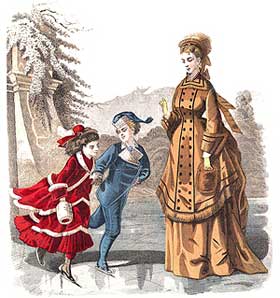| Fashion prints offer a
colorful and in-depth view of the stylish fashions of the past. Their vivid color schemes,
exquisite fabrics and decorative trims make a delightful collectible to display. |
|
|
|

The beautiful hand-colored antique fashion plates of the
late 18th and 19th century are considered a collectible art
form today. These prints were originally a means of
illustrating the current style of dress for designers,
artists, merchants, and manufacturers. They were most often
found in ladies' magazines.
The widespread publication of fashion plates began in
England and France in the late eighteenth century. The
English periodical, The Lady's Magazine, issued its
first uncolored plate in 1770 and a year later its first
color hand-tinted plate.
|
| |
|

Although antique fashion plates offer a basic history of
costume and fashion, some prints, especially of the
Directorie or Empire period, frequently depict an
idealistic image that was created by the artist. These
beautiful drawings often were an exaggeration of the period
fashions.
French
print from 1803 |
|
|
|
 Fashion plates reached their height of popularity in the
mid-1800s. By the end of the 19th century, one could find up
to 100 hand-tinted plates in a single year of a magazine.
Although most fashion designs throughout Europe were labeled
Parisian, many of the fashion magazines were published in
Germany (such as Modenwelt, Firmin-Didst, and
Der Bazar). Copyright laws in Europe were not
enforced and in
America
were non-existent, resulting in widespread piracy of fashion
designs and plates. Also it was not uncommon for
English and American magazines to modify and adapt French
and German plates to appeal to their own readership.
Young Ladies Journal, Godey's Ladies Magazine, Peterson's
Magazine, and others, copied nearly all of their fashion
plates. Most of these plates were printed on heavy paper and
the coloring was applied by hand. Fashion plates reached their height of popularity in the
mid-1800s. By the end of the 19th century, one could find up
to 100 hand-tinted plates in a single year of a magazine.
Although most fashion designs throughout Europe were labeled
Parisian, many of the fashion magazines were published in
Germany (such as Modenwelt, Firmin-Didst, and
Der Bazar). Copyright laws in Europe were not
enforced and in
America
were non-existent, resulting in widespread piracy of fashion
designs and plates. Also it was not uncommon for
English and American magazines to modify and adapt French
and German plates to appeal to their own readership.
Young Ladies Journal, Godey's Ladies Magazine, Peterson's
Magazine, and others, copied nearly all of their fashion
plates. Most of these plates were printed on heavy paper and
the coloring was applied by hand. |
| |
|

Early fashion plates typically showed single, elegantly
dressed figures, with no additional backgrounds. By the
mid-19th century, when color plates were most popular,
backgrounds had graduated from a single chair or column to
elaborate indoor and outdoor scenes. These scenes included
activities such as attending a ball, an afternoon at home,
promenading in the park, and an outing at the seashore. |
|
|
|

By the
1880s, American fashion magazines were including activities
other than those of the leisure class. Often one would find
color plates with a suggestion of a professional setting,
such as figures with a typewriter or sewing machine.
American periodicals often included the machine maker's name
in an attempt at advertising. |
| |
Antique & Vintage Fashion Prints - Make a Great Gift!
Explore our Store. |
 |
| |
|
Collectors can find colored antique fashion plates in many
places. Antique dealers and art galleries will charge top
prices. Secondhand shops, charity outlets and small antique
shops sometimes have framed prints hanging on the walls
above furniture, often with lower prices. Other inexpensive
places to look are frame shops and second hand bookstores in
small towns. Now with the popularity of the internet, many
web sites such as eBay, provide a vast variety of antique
prints and fashion plates. |
|
|
|

|
| |
|
As much attention should be given to the maintenance of
fashion prints as to their acquisition. The value of a piece
can be drastically diminished by improper care. The deep
crease caused by folding for the insertion in the original
magazine is usually fragile. Special care should be taken
when handling this type of print. Lift it with both hands,
to keep it from bending and never touch the printed area. In
either storing or framing, the best protection is a nonacid
tissue or matte board. Ultra-violet protection glass
is also recommended. |
|
|
|

|
|
|